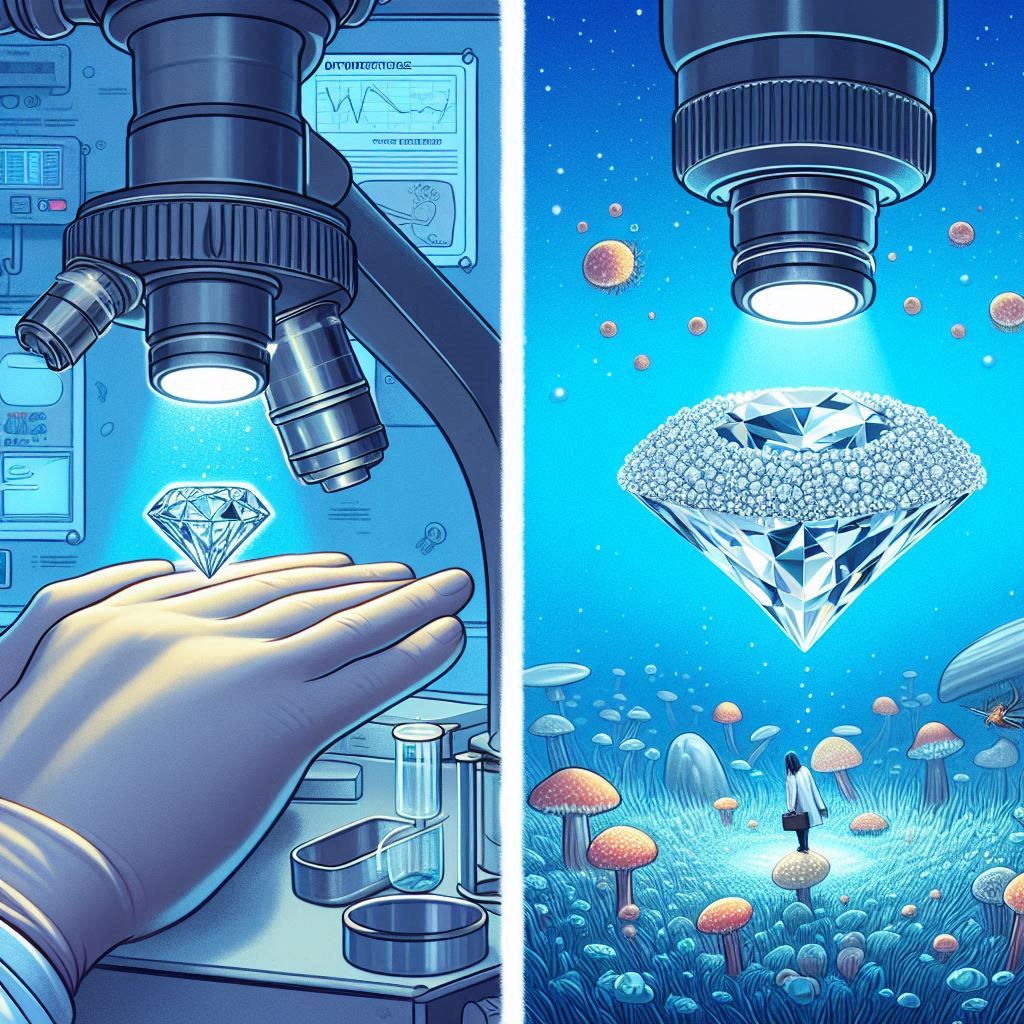The diamond industry worldwide has undergone massive change since lab-grown diamonds came up. The shocking resemblance of lab-grown diamonds to their natural counterparts made them popular each day. Natural diamonds are no longer the only type of diamond that rules the market. Man-made diamonds have done a great job of alluring diamond lovers worldwide with their amazing features and the advantages they offer. The two types of diamonds coexist in the market and have their own respective places and uses.
Lab-grown diamonds have impressed everyone with their striking similarities to natural diamonds. It isn’t that they are similar at all levels. In fact, many remain curious to know if they can find out or differentiate between the two types of diamonds or not. Well, that’s indeed possible. There are many ways that can help one differentiate between them, either at home or with diamond experts.
A trusted identification of lab-grown diamonds and natural diamonds could be better done by a diamond expert only. In fact, there’s been transparency maintained to keep lab-grown diamonds and natural diamonds separate in the diamond markets. Diamond merchants deal in both of these diamonds, and as such, they make sure their customers are aware of the origin of the diamonds they are willing to purchase.
No matter how popular lab-grown diamonds have become in the diamond market, There are many who want to know if their diamond is a natural diamond or a lab-grown one. To make sure the doubt is eliminated, there’s been plenty of ways to let one know about the type of diamond.
Before we dive deep into the factors that make natural diamonds and lab-grown diamonds different, we must clearly understand what these two diamonds actually are. Well, natural diamonds are the diamonds that are formed miles under the earth’s surface under high temperature and pressure in a natural environment.
Lab-grown diamonds, on the other hand, are the type of diamonds that are grown in labs. They are provided with a similar environment, like the natural diamonds, but only in the lab itself. The lab-grown diamonds may follow any of the two methods for diamond formation, which could be the high-pressure, high-temperature method or the chemical vapor deposition method.

Both are, as such, called the real diamonds. Not to forget, they are physically, chemically, and optically the same. Yet, there are many levels on which they are different from each other.
Now, let’s know how one can differentiate between these two types of diamonds.
Inscription on the diamond girdle
If you think about spotting the difference between a lab-grown diamond and a natural diamond with the naked eye, then you can’t see any difference that way. They are exactly the same, and only with proper examination can you tell the difference between them. To find the same, though, you can look for the inscription on the diamond girdle.
Every diamond, after its cutting and polishing, is taken for grading and certification in labs, where it is inscribed with a unique number. This inscription is found on the girdle of the diamonds, though you can’t see it with your naked eyes. You may need a magnifying glass with good magnification to see the inscription. The inscription might be really small, and hence, a good magnifying glass might be needed to see the inscription. With the same, one can tell if it’s a natural diamond or a lab-grown diamond.
Fluorescence pattern of diamonds
Another way to differentiate between lab-grown diamonds and natural diamonds is by checking their fluorescence patterns. This test can be done in the lab by experts after exposing the diamonds to ultraviolet light. Using this test, diamonds are exposed to ultraviolet light to see their fluorescence pattern.
To find out if a diamond is natural or lab-grown, experts check the light emitted by the gemstone. A natural diamond will have blue reflected light, whereas lab-grown diamonds will have orange reflected light. Thus, looking at the color of the reflected light itself, experts can tell which one is a lab-grown diamond.
This also helps in finding out the difference in the morphology of the diamonds. A natural diamond is an octahedron with eight-direction growth. Whereas lab-grown diamonds may have a cuboctahedron shape with 14 directions of growth for HPHT diamonds and a cubic shape with one direction of growth for CVD diamonds.
Grading report of the diamond
An authentic diamond always comes with a grading report, whether it is a lab-grown diamond or a natural one. The same institutions are responsible for grading both natural diamonds and their alternative diamonds, and they are checked for their 4Cs: cut, color, clarity, and carat. Hence, this might confuse many as to how to know if a diamond is natural or lab-grown.
Well, if you look at the grading report of the diamonds, you can find the origin of the diamond mentioned in it. The diamond industry wants buyers to be aware of the diamonds before buying them. It is clearly stated in the report whether the diamond is natural or a lab-grown diamond, making it easier for the owner of the diamond to know about it.
Price
There’s one more way to find out if that’s a natural diamond or a lab-grown diamond, and that’s by assessing its price. As we all know, lab-grown diamonds and natural diamonds have a difference in price. A lab-grown diamond could be 10 to 40% cheaper than natural diamonds. Hence, by looking at the price of the diamonds, we can also know which one is a natural diamond.
The reason behind that difference could be that natural diamonds are scarce and have a complex and really long process involved in their formation.
Other than these differences, there might be some other differences too that can’t be seen in the diamonds by merely looking at them, either at home or by a diamond expert. It could be something related to their impact on the environment and more. However, despite these differences, both natural diamonds and lab-grown diamonds are only called real diamonds.
If we throw light on their similarities, then physically, chemically, and optically, they are exactly the same, and there’s no visible difference between them.
Does the difference between natural diamonds and lab-grown diamonds affect their demand?
Natural diamonds and lab-grown diamonds co-exist in the diamond markets and have their own demands too. But after lab-grown diamonds gave budget-friendly real diamonds alike the natural diamonds, customers were more drawn towards trying the man-made diamonds. In fact, the jewelry industry has been loving the demands lab-grown diamonds have been getting.
Yet, what needs to be understood is that natural diamonds are rare, and their presence in the hearts of diamond lovers is still on top. Although lab-grown diamonds have been getting attention too, so, it isn’t wrong to say that the above-mentioned differences between the diamonds indeed affect their demands in favor of one or the other.
Takeover
Lab-grown diamonds might have some differences with natural diamonds. However, the differences aren’t enough to make them look completely different from the natural diamonds, which could affect their demands drastically. The above-mentioned differences may favor both natural diamonds and lab-grown diamonds, which makes them popular among diamond lovers in many ways.
In fact, it’s more about the two diamond types’ resemblance to each other that they co-exist in the diamond market worldwide. The differences, on the other hand, attract customers who appreciate those differences.
In the upcoming years, experts have suggested that the demand for both lab-grown diamonds and natural diamonds may rise, though the reasons behind each type’s rise in demand may be different. Conscious buyers may support lab-grown diamonds, while the recovery of the global economy may help in the rise of natural diamonds again.


